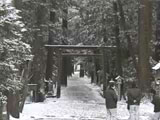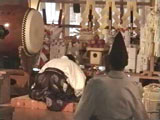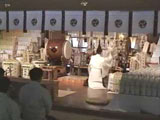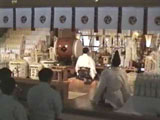

A. Shinto World-View
 |
The scholar, Tsunetsugu Muraoka, states that, in general,
"... the ancient outlook on life and the world was essentially one of unsophisticated optimism. Nature, as a manifestation of life-giving-power, was undisguisedly good. There could be no better world than this world. There were powers that obstructed and destroyed life-giving power, but in the end they would be overcome--"straightening" (naobi) action would be directed against these misfortunes ...As a result of such "straightening" action, life-giving power was perpetually winning. This was because good fortune was dominant. Possibly creativity (musubi), because of this, was a fundamental world principle."[Studies in Shinto Thought. Trans. by D.M. Brown and J.T. Araki. NY: Greenwood Press, 1988. pp.11, 29.]
Three essential Shinto insights are contained in this statement. First, in the human encounter with the world, nature is understood as creative and life-giving (musubi), a "generative...vital force" that connotes the sense of harmoniously creating and connecting. This vital power is directly associated with kami, the Japanese term given to those "unusual" and "superior" aspects of both nature and humanity that are experienced as possessing an awesome presence and potency, such as natural objects in heaven and earth (heavenly bodies, mountains, rivers, fields, seas, rain, and wind), and great persons, heroes, or leaders. This "myriad of kami" are not metaphysically different in kind from either nature or humanity, but rather are "superior" and "unusual" manifestations of that potency inherent in all life.
The second Shinto insight indicates that although we are grounded in the vital process of musubi and kami, we can also be disrupted and disjoined from it. In the tradition the more prevalent expression of this sense of obstruction is the term "pollution." "Purity," in turn, characterizes the state of creativity.
The third insight concerns the "straightening" action taken by humans to overcome those powers that obstruct or pollute the life-giving power of musubi and kami. There are a variety of means for achieving this, but it is principally through ritual actions ranging from formal liturgies conducted by priests in shrine precincts, to ascetic practices (misogi) and major public festivals. All these varied activities are conceived of in terms of ridding people and things of "pollution" (tsumi) in order to reinstate "purity."
There is an immediate and concrete nature to the Shinto sense of pollution. Tsumi is a dirty something that can be washed away by ablution and lustration (misogi harai) [cf. Muraoka 1988:59]. Wiping clean--lustration--restores the natural process, which is bright (akashi) and clean and beautiful. This also applies to the interior realities of human thought and intention: "the bad heart is a "dirty heart" which is malicious, and the pure heart is one which is not dirty--a bright heart that hides nothing. So the way of "straightening" or purification (harai) is basically the action of lustration, physically and mentally, which results in a condition of purity and beauty--wiping away the dust from the mirror. This aesthetic condition of beauty, in other words, is inseparable from a restored condition of purity. As Kishimoto Hideo states: "...religious values and aesthetic values are not two different things. Ultimately, they are one for the Japanese." ["Some Japanese Cultural Traits and Religions." Philosophy and Culture East and West, ed. Charles A. Moore. 1962: p. 251.] "The goal of life and art are one." [Uyeda, Isao. "Rites of Passage and Purification in Japanese Society," unpublished dissertation, 1991, p. 134.]
An aesthetically "pure and cheerful heart" (akaki kiyoki kokoro) is, consequently, the basis of communion with the kami, i.e., with the particular and "unusual potencies" of the creative process itself (musubi). In this state of purity, one is connected to the order and harmony of Great Nature, the "sacrality of the total cosmos." These, in brief, are some of the key insights that comprise the Shinto world-view and their idea of purity.
B. Shinto Ritual Practice
 |
Tsubaki Grand Shrine |
Because Shinto shrines are considered places of superior potency (kami) of the forces of life (musubi), it is in these locations that worship services are most regularly held. Our primary example here is the daily morning service (the Choo Hai) conducted at Tsubaki Grand Shrine located in Mie Prefecture at the base of one of seven mountains of Suzuka. The entire shrine complex is situated within a forest of 500 year old cypress trees. A large torii gate and an ablution pavilion mark the beginning of a path through the forest to the main shrine.
 |
The basic structure of this service is:
 |
(a) cleansing, preparations: from sweeping to washing, |
 |
|
(b) invocation of the kami through beautiful, sonorous words and sincere communication, |
 |
(c) offerings, and |
 |
(d) ritual purification. |
From beginning to end, the priests endeavor to courteously call upon and take leave of the kami through proper demeanor and formal bows and claps.
 |
Jump to: Introduction | Part II | Part III | About the Authors